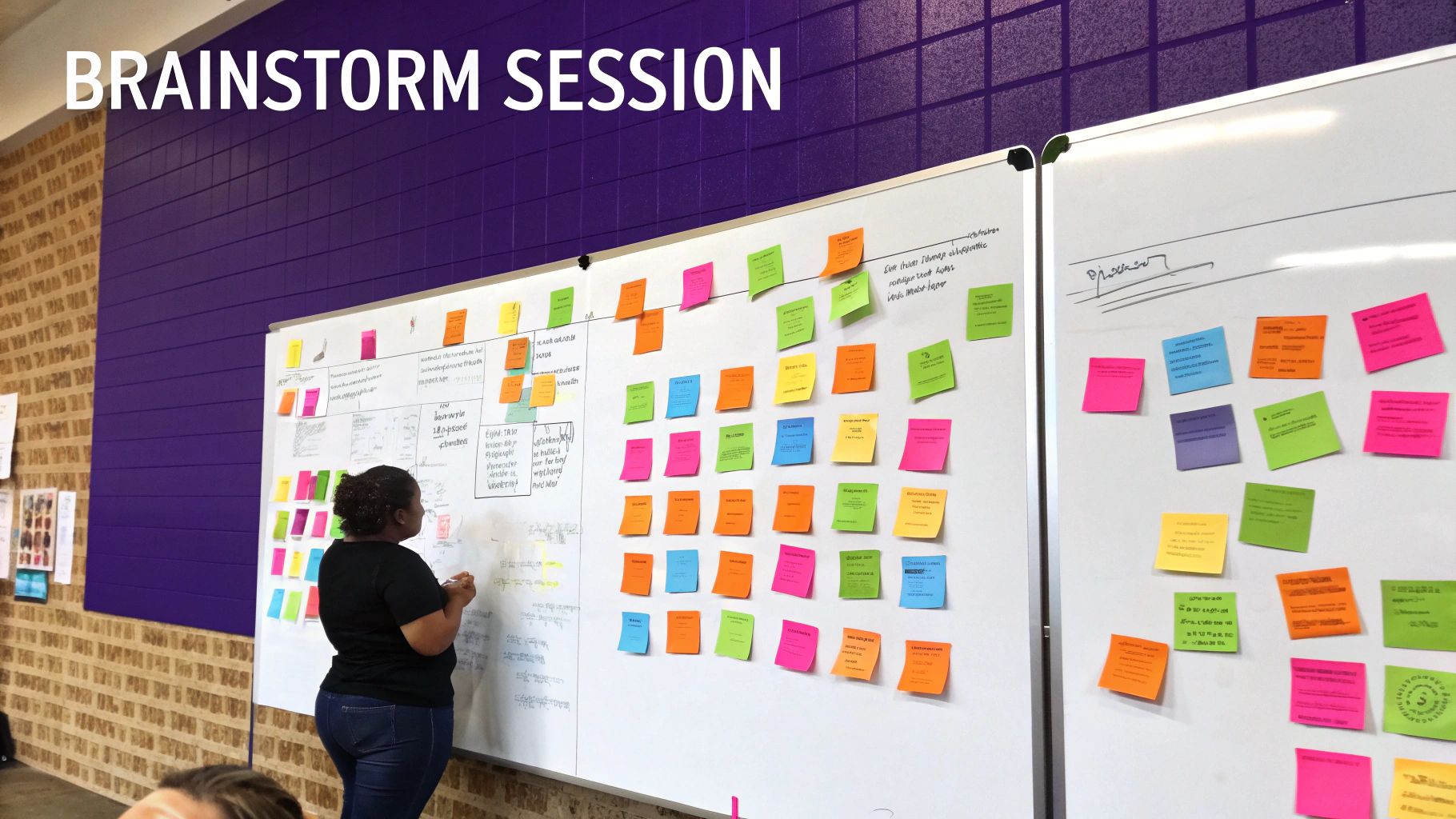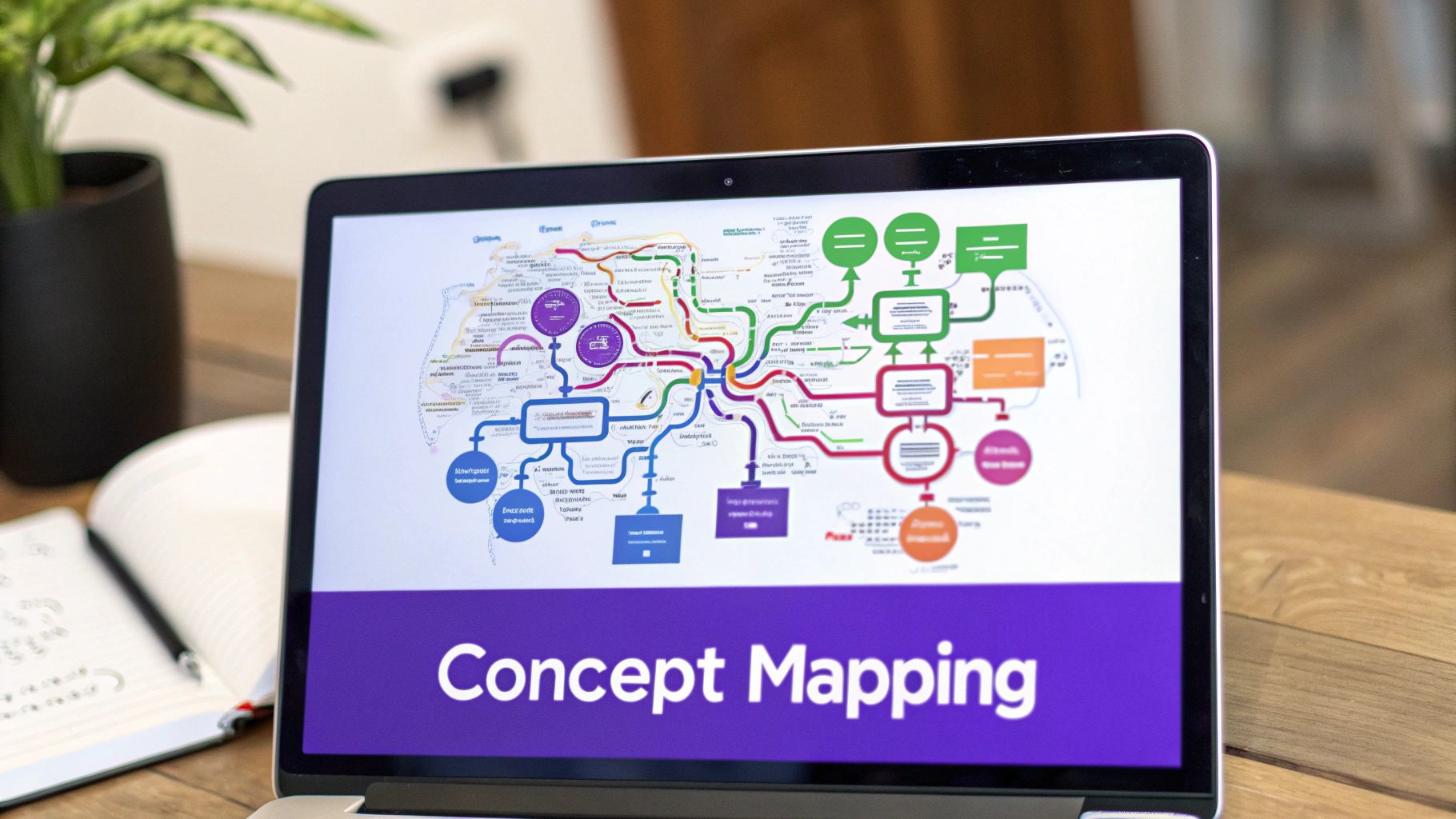The Evolution of Strategic Ideation
Ideation involves more than just forming ideas – it's a key part of how businesses develop solutions today. Companies need structured approaches to generate and implement ideas effectively. Let's explore how this process has evolved to meet modern challenges.
From Brainstorming to Structured Innovation
Traditional brainstorming had limitations – sessions often lacked focus and quieter voices went unheard. This led to the rise of design thinking methods that emphasize understanding user needs first, clearly defining problems, and quickly testing potential solutions through prototypes. The result is more practical ideas that truly serve users.
Consider how product development has changed: Instead of relying solely on internal brainstorming, companies now research customer pain points and test prototypes with real users before building solutions. This creates a feedback loop that leads to better products.
The Influence of Design Thinking
Design thinking has shaped modern ideation practices since the 1950s and 60s. Pioneers like Herbert Simon and Horst Rittel developed frameworks that businesses still use today. Want to learn more? Read about the history and principles of design thinking.
Modern Ideation: Embracing Collaboration and Technology
Today's ideation involves multiple elements working together:
- Cross-functional teams: Getting diverse perspectives by bringing different departments together
- Digital platforms: Using tools to enable remote collaboration and organize ideas
- Data insights: Analyzing market research and customer feedback to guide ideation
- AI assistance: Using artificial intelligence to spot trends and generate initial concepts
The focus now is on building sustainable innovation systems. By combining structured methods, collaborative tools, and data-driven approaches, companies can turn ideation into an engine for growth. Success comes from integrating these elements while keeping users at the center of the process.
Measuring Ideation's Impact on Business Growth

The real impact of ideation goes beyond just generating creative ideas – it directly affects business growth and success. To understand this connection, we need to look at how successful companies measure and track ideation outcomes.
Quantifying Ideation Success
While many companies find it challenging to connect ideation to business results, the most successful ones track specific Key Performance Indicators (KPIs). These include the number of ideas that make it into development, revenue from ideation-generated products, and user stories created during ideation workshops.
Let's look at the data comparing companies with strong ideation practices versus industry averages:
| Metric | Companies with Strong Ideation | Industry Average |
|---|---|---|
| Time to Market | 40% faster | Standard |
| Product Success Rate | 65% | 35% |
| Revenue Growth | 25% higher | Industry baseline |
| Return on Investment | 3x higher | Standard returns |
Metrics That Matter
Quality beats quantity when it comes to ideation. Smart businesses focus on metrics that show real value:
- Customer satisfaction scores: Changes in user reviews and Net Promoter Scores after implementing new ideas
- Development efficiency: Cost and time savings from better solution identification
- Sales performance: Revenue growth from products developed through ideation
Research shows the importance of these metrics. 70% of companies see innovation as crucial for long-term success, according to Gartner. McKinsey found that innovation-focused companies are 45% more likely to see above-average financial returns. Learn more about effective ideation methods on product ideation.
Building a Framework for Ideation ROI
A solid framework helps connect ideation work to business results. Key elements include:
- Clear objectives: Specific business goals for ideation activities
- Defined metrics: Key indicators to track progress
- Regular reporting: Consistent analysis and sharing of results
This structured approach ensures ideation efforts stay focused on business growth. It gives companies confidence that their ideation investments drive meaningful results.
Battle-Tested Ideation Techniques That Deliver Results

Now that we understand what ideation is and how it drives business growth, let's explore proven techniques that help teams consistently generate great ideas.
Classic Ideation Techniques: Time-Tested and Enhanced
Basic brainstorming still works well as a starting point. But modern methods build on this foundation to make it even better. For example, structured brainstorming assigns specific roles and uses targeted prompts to guide discussions and ensure everyone participates fully. When done right, teams can generate up to 100 ideas per hour – that's three times more than individuals working alone. Learn more about the creative process of ideation).
Using Design Thinking to Solve Problems
Design thinking provides a clear framework that puts users first throughout the ideation process. Teams start by deeply understanding user needs before creating solutions. Methods like user story mapping and empathy mapping help visualize the customer experience and spot improvement opportunities. This approach creates ideas that solve real problems people face.
Tools That Make Collaboration and Ideation Better
Good tools make a big difference in modern ideation. Bulby, built for remote teams, makes it easy to work together and capture ideas in real-time. Features like mind mapping and voting help organize and prioritize ideas. AI tools can also analyze trends and suggest initial ideas, helping spark new thinking.
Tips to Get More Creative Ideas
These proven practices help teams get better results from ideation:
- Define the problem clearly: A specific problem statement helps focus the discussion
- Create a welcoming environment: Everyone should feel safe sharing ideas and different viewpoints
- Test and improve ideas: Try new approaches and refine based on feedback
- Keep track of ideas: Write down everything and organize it for later review
Picking the Right Methods for Your Team
The best ideation approach depends on your specific challenge, how your team works, and what resources you have. Understanding the strengths of each technique and following best practices helps build an effective process that consistently generates valuable ideas. This creates a culture where new thinking thrives.
Inside Successful Ideation Transformations
Let's explore how different companies have successfully updated their approach to generating and developing new ideas. We'll look at key strategies, practical tools, and important cultural elements that helped them succeed.
Cultivating a Culture of Innovation
Creating great ideas starts with building the right environment. When employees feel safe sharing unusual or different perspectives without judgment, innovation thrives. Many companies now run "no wrong answers" brainstorming sessions to encourage open discussion. This helps everyone feel ownership of the creative process and empowers them to contribute their unique insights.
Strategies for Ideation Success
Smart ideation isn't random – it needs clear structure and goals. Many companies run specific programs with set timelines, often bringing together people from different teams and backgrounds. They also focus heavily on understanding what customers actually need. By starting with real customer problems, companies can direct their creative energy toward useful solutions. For example, Google's famous "20% time" policy let employees spend part of their week on side projects, leading to several successful products. Learn more about ideation approaches at Investopedia.
Using Tools and Technology
The right tools can make ideation much more effective. Digital platforms like Bulby help remote teams work together smoothly on idea generation and management. These tools enable real-time collaboration, voting on ideas, and organized discussion – even when team members are far apart. Features like mind mapping and idea grouping help teams spot connections between different concepts and build stronger solutions.
Overcoming Challenges and Maintaining Momentum
Changing how companies approach ideation isn't always easy. Common issues include:
- People resisting new ways of working
- Low participation levels
- Difficulty measuring results
Successful companies tackle these challenges by clearly explaining the benefits, providing good training, and tracking specific metrics. They celebrate both small victories and major breakthroughs to keep energy high and encourage ongoing innovation. This cycle of creating, testing, and improving ideas helps companies stay competitive and find new opportunities.
Building Your Ideation Engine

Success in ideation requires building a system that brings out your team's best creative potential. Let's explore the key elements needed to create an effective ideation process in your organization.
The following table outlines the essential components needed to build a strong ideation framework:
| Component | Purpose | Implementation Tips |
|---|---|---|
| Environment | Create psychological safety | Schedule dedicated ideation time, encourage open sharing |
| Structure | Guide the process | Set clear goals, use appropriate brainstorming tools |
| Collaboration | Combine diverse perspectives | Build cross-functional teams, facilitate knowledge sharing |
| Technology | Enable seamless workflow | Choose tools that support remote collaboration |
| Measurement | Track progress and impact | Monitor idea quality, quantity and implementation rate |
Creating the Right Environment for Ideation
Teams need to feel safe sharing unconventional ideas. The best way to foster this environment is by setting aside specific time for creative thinking. Many companies now dedicate full days, like "Innovation Fridays," solely to generating new ideas. This protected time helps teams step back from daily tasks and focus on fresh thinking.
Structuring Your Ideation Process
Random brainstorming rarely produces great results. The best ideation sessions have clear goals and use proven techniques to guide discussion. Tools like mind maps help organize thoughts, while software like Bulby enables structured remote brainstorming. Having the right process keeps teams focused and productive.
Building Cross-Functional Collaboration
Great ideas often emerge when different perspectives come together. For example, a product development session with marketing, engineering, and customer service team members will surface insights no single department could generate alone. This mix of viewpoints leads to more complete solutions.
Technology's Role in Ideation
The right tools make ideation flow smoothly, especially for remote teams. Platforms like Bulby help capture and organize ideas in real-time. While technology enables collaboration, it should support rather than replace human creativity. The best results come from balancing digital tools with genuine discussion.
Measuring and Optimizing Your Ideation Engine
Track key metrics like number of ideas generated, idea quality, and implementation speed to gauge your system's effectiveness. Regular analysis helps identify areas for improvement. Companies like Google show how a well-designed ideation process, backed by the right tools and culture, drives major breakthroughs.
The Future of Strategic Ideation

As technology and work styles change, the way we generate and develop ideas is also shifting. Let's explore the key developments shaping how teams come up with great ideas and how businesses can make the most of these changes.
The Rise of AI in Ideation
Artificial intelligence is now an active partner in creative work. AI tools can process large amounts of data and spot patterns that spark new ideas. Teams can now skip hours of research and jump straight into exploring fresh concepts. For instance, AI can sort through customer comments to find unmet needs, giving teams solid starting points for brainstorming.
Virtual Collaboration: Ideation Across Distances
With more teams working remotely, online collaboration tools have become essential for brainstorming. These platforms help teams share ideas effectively, no matter where they're located. Modern features like live idea sharing, voting tools, and digital whiteboards make online brainstorming just as good as – or even better than – in-person sessions.
Emerging Ideation Methods
New approaches to generating ideas are gaining popularity alongside classic brainstorming. Many new methods use elements from games, behavioral research, and data analysis to boost creativity while staying focused on business goals. Challenge-based ideation is one example – teams tackle specific real-world problems, which leads to more practical solutions.
Separating Hype from Value in New Ideation Trends
Not every new ideation tool or method will work for every organization. The key is careful testing and thoughtful adoption. Consider your:
- Team size
- Industry type
- Specific goals
- Current workflows
A small startup might do well with a simple AI brainstorming tool, while larger companies may need more complex platforms that work with their existing systems.
Positioning Your Organization for the Future of Ideation
Success with new ideation approaches requires a culture of learning and testing. Key steps include:
- Training teams on new tools and methods
- Encouraging open communication
- Setting clear metrics to measure results
- Being willing to try new approaches
By staying flexible and focused on results, organizations can use new ideation methods to drive meaningful innovation.
Ready to improve your remote team's brainstorming? Try Bulby, the collaboration platform designed for remote ideation.

